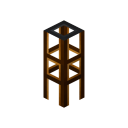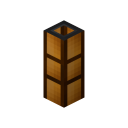Fluiduct

A fluiduct is a block that transfers fluids between blocks.
Obtaining
A placed fluiduct can be instantly picked up by dismantling it with a wrench. It can also be mined using a pickaxe.
Crafting
| Result(s) | Ingredients | Crafting recipe |
|---|---|---|
| Fluiduct | Copper Ingot + Glass | |
| Fluiduct (Opaque) | Copper Ingot + Lead Ingot | |
| Fluiduct (Opaque) | Fluiduct + Lead Ingot | |
| Fluiduct | Fluiduct (Opaque) + Glass |
Usage
Placement
When placed, a fluiduct connects to any adjacent fluiducts and blocks that can output or receive fluids. Any connected side of a fluiduct can be disconnected and reconnected by using a wrench on it.
Fluid transfer
When a block inserts a fluid into a fluiduct, the fluid is distributed to all connected blocks that can receive it, as evenly as possible. A fluiduct can transfer only one type of fluid at a time.
A limited amount of fluid per tick can be transferred through each fluiduct connection. However, there is no limit on how much fluid can travel through a fluiduct itself.
A network of fluiducts can store a certain amount of fluid, so that unloaded chunks do not immediately cause it to stop supplying the fluid to blocks. The fluid capacity of a network is proportional to the amount of blocks connected to it.
The maximum throughput of a fluiduct per connection depends on the viscosity of the transferred fluid, and can be between 80 and 600 mB/t (this can be read using a multimeter). The actual throughput per connection depends on how full the fluiduct network is. A fully pressurized fluiduct network uses the maximum throughput per connection, while a nearly empty fluiduct network uses only half of this.
A fluiduct will break if it contains an extremely hot or cold fluid like lava or gelid cryotheum. To transfer these fluids, a hardened fluiduct must be used.
Attachments
Certain items can be attached to fluiduct connections to change how fluiducts work. Servos allow fluiduct connections to pull fluids out of blocks, filters allow them to restrict which fluids may pass through, and retrievers allow them to pull fluids towards themselves from other blocks connected to the network.
Light source
A transparent fluiduct will emit light when it contains a fluid that emits light, like lava or energized glowstone.
Last updated: 2022-08-16 07:03:26 +0000
